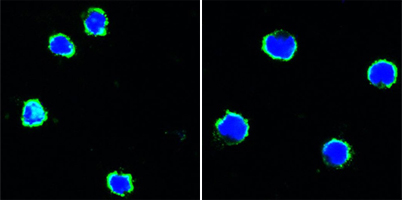CD40 Monoclonal Antibody
- Catalog No.:YM0126
- Applications:IF;ELISA
- Reactivity:Human
- Target:
- CD40
- Fields:
- >>Cytokine-cytokine receptor interaction;>>NF-kappa B signaling pathway;>>Cell adhesion molecules;>>Toll-like receptor signaling pathway;>>Intestinal immune network for IgA production;>>Malaria;>>Toxoplasmosis;>>Human T-cell leukemia virus 1 infection;>>Epstein-Barr virus infection;>>Transcriptional misregulation in cancer;>>Asthma;>>Autoimmune thyroid disease;>>Systemic lupus erythematosus;>>Allograft rejection;>>Primary immunodeficiency;>>Viral myocarditis;>>Lipid and atherosclerosis
- Gene Name:
- CD40
- Protein Name:
- Tumor necrosis factor receptor superfamily member 5
- Human Gene Id:
- 958
- Human Swiss Prot No:
- P25942
- Mouse Swiss Prot No:
- P27512
- Immunogen:
- Purified recombinant fragment of CD40 expressed in E. Coli.
- Specificity:
- CD40 Monoclonal Antibody detects endogenous levels of CD40 protein.
- Formulation:
- Purified recombinant fragment of CD40 expressed in E. Coli.
- Source:
- Monoclonal, Mouse
- Dilution:
- IF 1:200 - 1:1000. ELISA: 1:10000. Not yet tested in other applications.
- Purification:
- Affinity purification
- Concentration:
- 1 mg/ml
- Storage Stability:
- -15°C to -25°C/1 year(Do not lower than -25°C)
- Other Name:
- CD40;TNFRSF5;Tumor necrosis factor receptor superfamily member 5;B-cell surface antigen CD40;Bp50;CD40L receptor;CDw40;CD antigen CD40
- References:
- 1. Clin Cancer Res. 2003 Feb;9(2):722-8.
2. Clin Cancer Res. 2003 Feb;9(2):619-24.
3. Immunity. 1999 Sep;11(3):339-48.
- Background:
- This gene is a member of the TNF-receptor superfamily. The encoded protein is a receptor on antigen-presenting cells of the immune system and is essential for mediating a broad variety of immune and inflammatory responses including T cell-dependent immunoglobulin class switching, memory B cell development, and germinal center formation. AT-hook transcription factor AKNA is reported to coordinately regulate the expression of this receptor and its ligand, which may be important for homotypic cell interactions. Adaptor protein TNFR2 interacts with this receptor and serves as a mediator of the signal transduction. The interaction of this receptor and its ligand is found to be necessary for amyloid-beta-induced microglial activation, and thus is thought to be an early event in Alzheimer disease pathogenesis. Mutations affecting this gene are the cause of autosomal recessive hyper-IgM immunodeficiency type 3 (HIG
- Function:
- alternative products:Additional isoforms seem to exist,disease:Defects in CD40 are the cause of hyper-IgM immunodeficiency type 3 (HIGM3) [MIM:606843]. HIGM3 is an autosomal recessive disorder which includes an inability of B cells to undergo isotype switching, one of the final differentiation steps in the humoral immune system, an inability to mount an antibody-specific immune response, and a lack of germinal center formation.,function:Receptor for TNFSF5/CD40LG.,online information:CD40 entry,online information:CD40 mutation db,similarity:Contains 4 TNFR-Cys repeats.,subunit:Monomer and homodimer. The variant form found in the bladder carcinoma cell line Hu549 does not form homodimers. Interacts with TRAF1, TRAF2, TRAF3, TRAF5 and TRAF6.,tissue specificity:B-cells and in primary carcinomas.,
- Subcellular Location:
- [Isoform I]: Cell membrane; Single-pass type I membrane protein.; [Isoform II]: Secreted.
- Expression:
- B-cells and in primary carcinomas.
- June 19-2018
- WESTERN IMMUNOBLOTTING PROTOCOL
- June 19-2018
- IMMUNOHISTOCHEMISTRY-PARAFFIN PROTOCOL
- June 19-2018
- IMMUNOFLUORESCENCE PROTOCOL
- September 08-2020
- FLOW-CYTOMEYRT-PROTOCOL
- May 20-2022
- Cell-Based ELISA│解您多样本WB检测之困扰
- July 13-2018
- CELL-BASED-ELISA-PROTOCOL-FOR-ACETYL-PROTEIN
- July 13-2018
- CELL-BASED-ELISA-PROTOCOL-FOR-PHOSPHO-PROTEIN
- July 13-2018
- Antibody-FAQs
- Products Images

- Confocal immunofluorescence analysis of human peripheral blood lymphocyles (left) and mouse L1210 cells (right) using CD40 Monoclonal Antibody (green). Blue: DRAQ5 fluorescent DNA dye.



